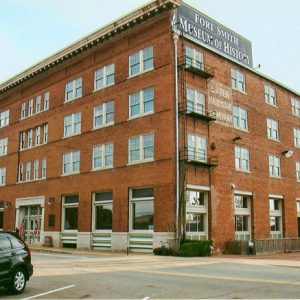calsfoundation@cals.org
Fort Smith Museum of History
Since 1910, the Fort Smith Museum of History has acquired, preserved, exhibited, and interpreted objects of historical significance relevant to the founding and growth of Fort Smith (Sebastian County) and the region. Previously known as the Old Commissary Museum and the Old Fort Museum, the current name has identified the museum since 1999.
The museum has its beginnings in 1910, when a group of local women learned that the city was planning to tear down its earliest remaining military structure. This building, known as the Old Commissary Building, was a significant historical site. Construction began in 1838, and it was used in various ways by the U.S. Army before being abandoned. It was purchased by the City of Fort Smith in 1898. The City Federation of Women’s Clubs leased the building from the city and began to operate the Old Commissary Museum. The facility became the recipient of some of Fort Smith’s cultural artifacts.
Later, the famous gallows were rebuilt, and the other buildings in the area were restored. When plans developed in 1960 for a National Historic Site under the supervision of the National Park Service, the women were asked to release the city from its lease. The museum and its contents were moved to a temporary building on Garrison Avenue. In 1979, after acquiring the present historic structure, the Atkinson-Williams Building adjacent to the National Historic Site, the Old Commissary Museum became the Old Fort Museum. (The Atkinson-Williams building was listed on the National Register of Historic Places on December 12, 1979.) In 1999, in order to clarify its identity, the name was changed to the Fort Smith Museum of History.
The museum offers a timeline that relays, through artifacts and supporting graphics, the unique history of Fort Smith. This is augmented by the Transportation Gallery, a working 1920s-era soda fountain/pharmacy, and the Boyd Gallery. The William O. Darby Room honors a local hero, the man who organized Darby’s Rangers during World War II. A hands-on telephone exhibit is maintained by the Telephone Pioneers, an organization that consists of retired Southwestern Bell employees. The museum displays a 1,500-piece doll exhibit and has one of the world’s largest collections of Niloak Pottery.
The second floor houses the Chaffee Exhibit, which highlights the many roles that Fort Chaffee has played. As an infantry training camp, it housed German prisoners of war during World War II. It later gave temporary asylum to Vietnamese and Laotian refugees, and even later to Cuban refugees. Elvis Presley got his first military haircut there.
Fort Smith was known as a rough and rowdy border town in its early days. Rotating exhibits have represented the rich history of Fort Smith and the region, celebrating the settling of the frontier, the move into the twentieth century, baseball in Fort Smith, the stories of Belle Starr and other local outlaws, the city’s various ethnic histories and cultures, and much more. In 1998, “In the Shadow of the Gallows” was named best exhibit by the Arkansas Museums Association. Every October, the museum’s popular “Murder & Mayhem Trolley” recounts entertaining overviews of Fort Smith’s checkered and colorful past. This event won a coveted Henry Award in 2005.
For additional information:
“Atkinson-Williams Building.” National Register of Historic Places nomination form. On file at Arkansas Historic Preservation Program, Little Rock, Arkansas. Online at http://www.arkansaspreservation.com/National-Register-Listings/PDF/SB0413.nr.pdf (accessed August 30, 2022).
Faulk, Odie B., and Billy Mae Jones, Fort Smith: An Illustrated History. Fort Smith, AR: Old Fort Museum, 1983.
Fort Smith Museum of History. http://www.fortsmithmuseum.org (accessed August 30, 2022).
Patton, J. Fred. The History of Fort Smith: 1817 through 2003. 7th ed. North Little Rock, AR: Prestige Publishing, 1992, 2004.
Suzy Laird
Fort Smith Museum of History
Staff of the CALS Encyclopedia of Arkansas
 Fort Smith Historical Society
Fort Smith Historical Society Fort Smith Museum of History
Fort Smith Museum of History 




Comments
No comments on this entry yet.